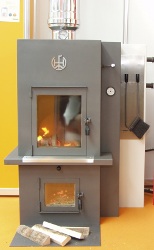|
 The principle of wood heating is as follows: wood burned in the boiler (central heating) is used to heat water which then circulates throughout the house and is distributed to the radiator or heated floors. Closed chimneys or inserts are very efficient when it comes to heating a particular room. There are three kinds of wood and each kind has its appropriate type of boiler. The principle of wood heating is as follows: wood burned in the boiler (central heating) is used to heat water which then circulates throughout the house and is distributed to the radiator or heated floors. Closed chimneys or inserts are very efficient when it comes to heating a particular room. There are three kinds of wood and each kind has its appropriate type of boiler.
Firstly: the conventional logs, 33 or 50 cm. Sticks, same formats as the logs, are made of reconstituted wood; their moisture content is only from 8 to 10%, making it an excellent fuel with high calorific value.
Secondly: the plates, which come in the form of chips. These wood chips are used in boilers with automatic feeding: the boiler is directly connected to the silo, so there is no need to feed it with logs every two or three days.
Thirdly: the granules, or pellets. They are pressed wood, compressed and reconstructed from sawdust. It is extremely dense and it allows very compact storage and automatic functioning of boilers and stoves. With moisture content below 10%, granules have a high calorific value: 1 ton of pellets is equivalent to 500 liters of oil.
Whatever the form of wood may be, the key parameter is its moisture content, ideally below 20%. It is the same logic as for a conventional fire: dry wood burns better! Wet wood will foul the equipment and pollute more. The wood is to be kept in a dry and well ventilated place.
Wood heating is clearly a clean and green heating, because it is considered that between the time a tree is planted and the time it is burned, it captures more CO2 than it releases during combustion.
Finally, the tax credit for installing wood boilers offsets the price differential with gas boilers or oil, three to four times cheaper.
|